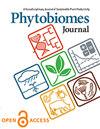Phyllosphere Exudates Select for Distinct Microbiome Members in Sorghum Epicuticular Wax and Aerial Root Mucilage
IF 2.6
3区 生物学
Q2 MICROBIOLOGY
引用次数: 4
Abstract
Phyllosphere exudates create specialized microhabitats that shape microbial community diversity. We explored the microbiome associated with two sorghum phyllosphere exudates, the epicuticular wax and aerial root mucilage. We assessed the microbiome associated with the wax from sorghum plants over two growth stages, and the root mucilage additionally from nitrogen-fertilized and nonfertilized plants. In parallel, we isolated and characterized hundreds of bacteria from wax and mucilage, and integrated data from cultivation-independent and cultivation-dependent approaches to gain insights into exudate diversity and bacterial phenotypes. We found that Sphingomonadaceae and Rhizobiaceae families were the major taxa in the wax regardless of water availability and plant developmental stage to plants. The cultivation-independent mucilage-associated bacterial microbiome contained the families Erwiniaceae, Flavobacteriaceae, Rhizobiaceae, Pseudomonadaceae, and Sphingomonadaceae, and its structure was strongly influenced by sorghum development but only modestly influenced by fertilization. In contrast, the fungal community structure of mucilage was strongly affected by the year of sampling but not by fertilization or plant developmental stage, suggesting a decoupling of fungal–bacterial dynamics in the mucilage. Our bacterial isolate collection from wax and mucilage had several isolates that matched 100% to detected amplicon sequence variants, and were enriched on media that selected for phenotypes that included phosphate solubilization, putative diazotrophy, resistance to desiccation, capability to grow on methanol as a carbon source, and ability to grow in the presence of linalool and β-caryophyllene (terpenes in sorghum wax). This work expands our understanding of the microbiome of phyllosphere exudates and supports our long-term goal to translate microbiome research to support sorghum cultivation.高粱表皮蜡和气根粘液中不同微生物组成员的层球分泌物选择
层球渗出物创造了特殊的微栖息地,塑造了微生物群落的多样性。我们研究了两种高粱叶层渗出物、表皮蜡和气根粘液相关的微生物群。我们评估了高粱植株在两个生长阶段与蜡相关的微生物组,以及氮肥和未施肥植株的根粘液。同时,我们从蜡和粘液中分离和表征了数百种细菌,并整合了培养独立和培养依赖方法的数据,以深入了解渗出物多样性和细菌表型。结果表明,无论植物的水分利用率和发育阶段如何,Sphingomonadaceae科和Rhizobiaceae科都是蜡中的主要分类群。与栽培无关的黏液相关细菌微生物组包括Erwiniaceae、Flavobacteriaceae、Rhizobiaceae、Pseudomonadaceae和Sphingomonadaceae,其结构受高粱发育的强烈影响,而施肥对其影响较小。相比之下,粘液的真菌群落结构受到采样年份的强烈影响,而不受施肥或植物发育阶段的影响,这表明粘液中真菌-细菌动力学解耦。我们从蜡和粘液中收集的细菌分离物中有几个分离物与检测到的扩增子序列变异100%匹配,并且在选择的表型培养基上富集,这些表型包括磷酸盐增溶性,推测的重氮性,抗干燥性,在甲醇作为碳源上生长的能力,以及在芳樟醇和β-石竹烯(高粱蜡中的萜烯)存在下生长的能力。这项工作扩大了我们对层际渗出物微生物组的理解,并支持我们将微生物组研究转化为支持高粱种植的长期目标。
本文章由计算机程序翻译,如有差异,请以英文原文为准。
求助全文
约1分钟内获得全文
求助全文

 求助内容:
求助内容: 应助结果提醒方式:
应助结果提醒方式:


